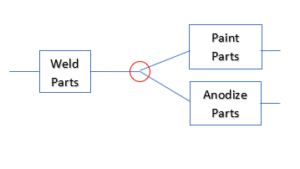World class organizations always begin their improvement practice by drawing the process that they are trying to improve. A box for each activity filled with a verb and noun that describe the work content as well as lines showing the flow of material. There is a very clear message in the draw that comes from drawing the lines. Any time there is a fork – there is a decision.
A fork is not ideal, because a fork requires a decision, and a decision requires a person, a computer, or a visual system.
A Fork Requires a Person
A fork represents a decision. After we weld the parts; do we paint them or anodize them? That decision is often answered in most organization by a person. The role is either Planner, Scheduler, Expeditor, Lead Person, or Supervisor. The person is a resource employed by the organization to make decisions created by the fork.
If we were to create two welding areas and all Painted parts were welded in one area and all the Anodized parts were welded in another, the decision is moved to before welding. Continuing this logic will eventually create a point from which the order will be launched to the shop and everything will just flow from there though the process without decisions being needed.
A Fork Requires a Computer
A fork represents a decision. After welding the parts; do we paint them or anodize them? Many software companies offer solutions for answering all these questions. Logarithms are written based on criteria to make the decision and printed or displayed. The print outs or displays are then interpreted and the decisions are executed on the shop floor.
If we were to create two welding areas and all Painted Parts were welded in one area and all the Anodize Parts were welded in another, the decision goes away and the need for the visual system goes away.
Help your organization draw their process and see where forks drive decisions. Then do your best to eliminate them.





Speak Your Mind